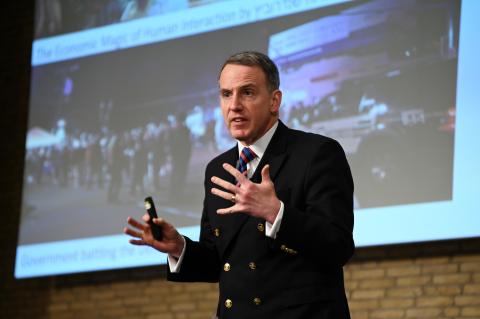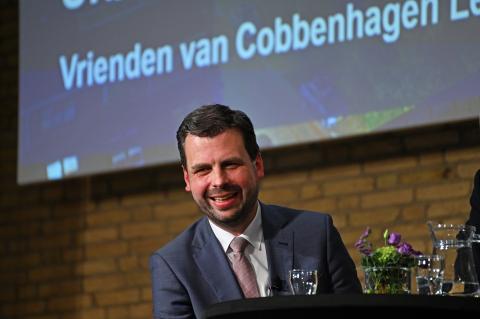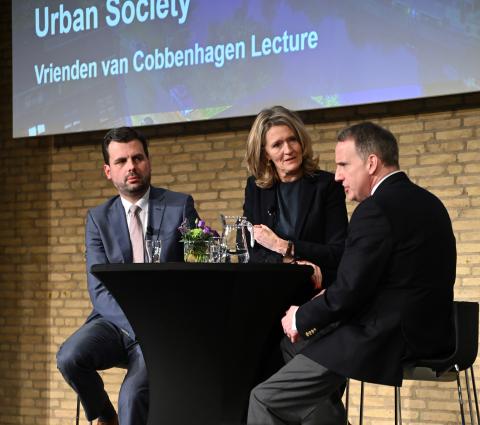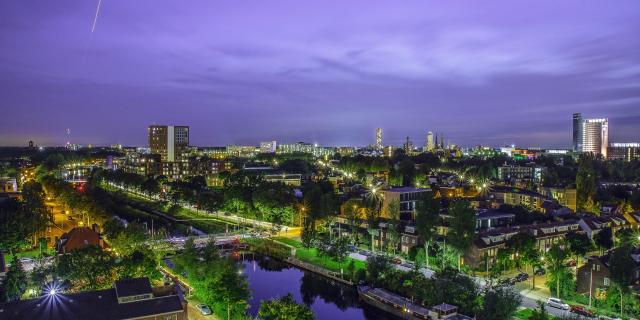Friends of Cobbenhagen Lecture 2020
Cities grow. This has consequences with respect to affordable housing, security, career opportunities, and problems of segregation. How can the government ensure continued quality of life in cities? “It hinges on good rules,” says Harvard Professor Edward Glaeser during the fourth Vrienden van Cobbenhagen Lecture on January 23, 2020.
Vrienden van Cobbenhagen, alumni, students, and university staff meet during the Vrienden van Cobbenhagen Lecture - Urban Society . Professor Edward Glaeser presented the keynote: ‘The Pros and Cons of Urbanization’. They are not disappointed. Glaeser goes through his slides in fast-forward mode, substantiates claims with data, explains causes and effects, and takes those present in the Auditorium on a roaring journey through the history of urbanization.
Human interaction is the city’s greatest benefit
The benefits of the city
“That we are meeting here face to face today is a sign of what makes cities great,” is Glaeser’s opening sentence. “Because we are in contact with each other, we can work miracles together which we couldn’t achieve alone. Human interaction has advantages like trade, mutual assistance, and information exchange. There are also downsides, for instance, crime and the spreading of viruses. An effective public sector ensures that contacts run smoothly. The city is not the skyline, but the people who live there. The infrastructure and buildings don’t work if they don’t serve citizens’ needs.”
Bekijk de hele lecture via YouTube
Zooming in on Tilburg
While Glaeser shed an international light on urbanization, alderman Berend de Vries zooms in on Tilburg. The city in which Tilburg University is located boasts a flourishing past in the textile industry. In the late 19th century, approximately 13,000 residents worked in this sector. After 1950, companies left for low-wage countries and Tilburg had to reinvent itself, focusing on logistics and business. De Vries: “Like Eindhoven, Tilburg is now a strong university city that drives innovation. 13 to 15 % of our residents are students. We are now in transition from low-wage labor in the textile industry to a knowledge city.”
Question time
After Professor Glaeser and alderman De Vries’ lectures, moderator Simone van Trier and people in the audience ask interesting and stimulating questions. For example, whether the city can actually say: ‘These are the people we want to attract’?
Read the full report on the Vrienden van Cobbenhagen Lecture in Tilburg University Magazine.
Edward Glaeser
Edward Glaeser is the Fred and Eleanor Glimp Professor of Economics at Harvard University's Faculty of Arts and Sciences, where he has been working since 1992. He is a regular lecturer on microeconomics, complemented by urban and public economics. He was director of the Taubman Center for State and Local Government and director of the Rappaport Institute for Greater Boston. He has published dozens of articles on economic growth, the law and the economy of cities. His work focused in particular on the determinants of urban growth and the role of cities as centres of idea transfer. He obtained his PhD from the University of Chicago in 1992. His books include Cities, Agglomeration, and Spatial Equilibrium (Oxford University Press, 2008), Rethinking Federal Housing Policy (American Enterprise Institute Press, 2008) and Triumph of the City (Penguin Press, 2011).
During his visit to Tilburg University, Edward Glaeser did a podcast with Betrouwbare Bronnen:

Berend de Vries
Berend de Vries grew up in the Achterhoek, but has lived in Tilburg since 1995. After studying Dutch Law at Tilburg University, he worked there for several years as a researcher. He then became senior policy advisor at the Ministry of Economic Affairs in The Hague. Since 2010 he has been alderman of Tilburg for D66. He is responsible for Economy, Circular Economy, Spatial Planning, Energy Transition, City Marketing, BrabantCity and the projects: Spoorzone, Piushaven and Stappegoor. He is also a district alderman for Groenewoud, Noordhoek and Koningshaven. Since October 2010, at the request of the national climate ambassador, he has been taking part in the ambassadors' consultations of local authorities and the national government in that capacity.


Curious about the pictures?
Urban Sessies
Prior to the 'Lecture', three sessions took place on Urban Society.
Smart urban intermediaries
Researcher Merlijn van Hulst did his research into the role of smart urban intermediaries. Who are these key figures within a community? They make the difference in underprivileged neighborhoods. How do they work? With whom? And what are points of attention and risks? How do you make them socially distressed? A fascinating accessible session about difference-makers and how government can help them to improve society. His next project will be official craftsmanship.
Buying or selling first in the Dutch housing market
Dr. Florian Sniekers enthusiastically showed many models that support the results of his research. Models that help you decide whether you want to live in a caravan temporarily. Or with your parents-in-law. Or rather pay monthly charges for -temporarily- two homes. The bottom line is that the housing market distinguishes itself from many other markets because homeowners who want to move are both buyers and sellers. By choosing whether to buy or sell first, these homeowners influence the relationship between buyers and sellers. This has important consequences for the selling time, the number of transactions, the number of houses for sale, and house prices.
Historische Atlas van Tilburg
Rob van Putten used maps and illustrations to sketch a picture of the specific development of Tilburg, where the current city arose out of a number of small cores, known as 'herdgangen'. In this session Pieter Siebers, project leader of Academic Heritage at the university, then discussed the rather special arrival of higher education in the city, in which figures such as Moller, Goossens and Cobbenhagen played a prominent role. With photo's that were shown never before, he showed the first 35 years of the university, then college, which was located in the city center until 1962. He continued by illustrating the development of the current campus. From moving to the De Reit district, emergency buildings from the 1970s to shifting the axis of the campus from west to east, instead of south to north, with the buildings Esplanade, Dante, Simon, Montesquieu and Academia, and branches in the city center, Den Bosch and Utrecht.
Text: Melinde Bussemaker, photografphy: Freddie de Roeck, Frans van Aarle
Join Friends of Cobbenhagen
With your membership you support special programs such as the Outreaching Honors Program, you actively give meaning to society and it also brings you many benefits: for example, you can attend interesting meetings with top speakers and company visits.
